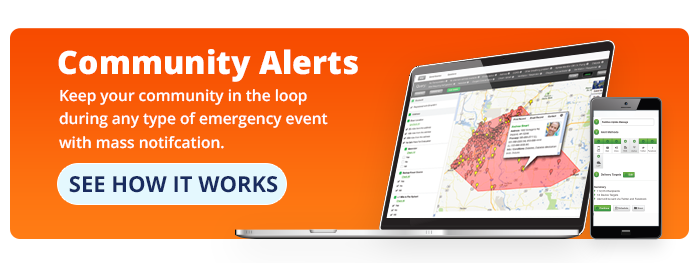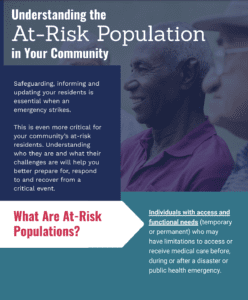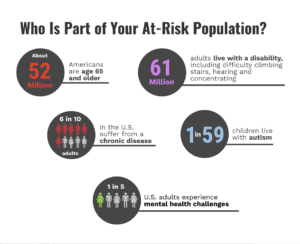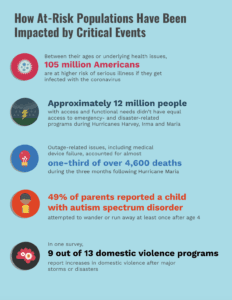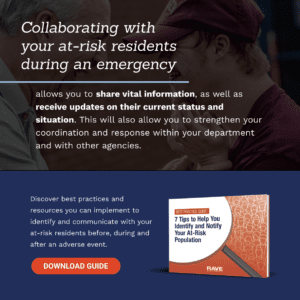How Mass Notification Helps to Identify and Communicate with Your At-Risk Population
Notifying residents about a public health emergency. Evacuating them before a wildfire or a hurricane strikes. Initiating rescue efforts to a flooded neighborhood. Providing comfort to the community after an active assailant incident. Safeguarding community members is one of many priorities for emergency managers, 9-1-1 teams, first responders, public health personnel and local government officials. It’s essential for these stakeholders to have the tools to communicate effectively with residents, as well as with each other.
But one of the biggest challenges is identifying everyone in a community, especially those who will need help and what actions emergency managers, 9-1-1 teams, first responders and public health officials will need to take. States and local officials don’t always know where these residents live, or how many individuals there are. Having this information will allow emergency management and public safety and health agencies better prepare these community members for an emergency, while they understand what resources they will need to allocate.
The Definition of an At-Risk Population
So who is considered to be at risk? The definition varies depending upon certain criteria.
The Department of Health and Human Services (DHS) states an at-risk individual is someone with “access and functional needs (temporary or permanent) that may interfere with their ability to access or receive medical care before, during or after a disaster or public health emergency.” The agency defines at-risk individuals as children, older adults, pregnant women and individuals experiencing homelessness or have chronic health conditions.
Individuals with access and functional needs may include seniors and people with physical, sensory, behavioral, mental health, intellectual, developmental and cognitive disabilities, according to the Federal Emergency Management Agency (FEMA). They may also have limited English language proficiency, and access to transportation and/or financial resources to prepare for, respond to and recover from an emergency.
The Centers for Disease Control and Prevention (CDC) defines an individual in a vulnerable population as someone who requires constant supervision, has difficulty communicating and accessing medical care, and may need help maintaining independence or accessing transportation.
Who Makes Up the At-Risk Population in Your Community?
- About 52 million Americans are age 65 and older
- 6 in 10 adults in the U.S. live with a chronic disease
- 61 million adults live with a disability, including climbing stairs, hearing and concentrating
- More than 25 million Americans experience asthma
- Over 24 million people suffer from an autoimmune disease
- 1 in 5 U.S. adults experience mental health challenges
- About 2.5 million individuals are reliant on electricity for in-home medical equipment
- Almost 6 million Americans live with Alzheimer’s disease
- 1 in 59 children live with autism
Once these residents are identified, how will these residents know what’s going on? What happens if there isn’t enough information collected and known about them? How will emergency personnel reach out to those who need help?
The Challenges to Register At-Risk Residents
Once they have identified who may have a high risk during an emergency, what do agencies do with this information? Here are some other questions agencies need to consider:
- What information needs to be collected?
- Who will be included?
- Where does this data stay?
- What information will be shared during an emergency? How?
- How will residents benefit from this data collection?
Agencies would collect this information and place it into a registry. The objective of this kind of registry would ensure the right public safety and health resources are in the right place at the right time. The registry would identify the number of registered residents who require assistance, as well as their locations and needs. It would help key stakeholders prepare for what resources might be needed before an emergency, and send them out when the time came. For example, emergency managers would know where at-risk residents live so they can evacuate them prior to flooding.
So where would this data be stored?
Some agencies have created their own databases so individuals with access and functional needs and other chronic conditions can self-identify and share their information. But the database is oftentimes stored locally and can’t be shared across jurisdictions or even across agencies, meaning that the data goes completely unused or can get stale quickly. Another challenge is the curation and maintenance of the database falls to agency personnel, which is time-consuming on top of the tasks they already have.
Other agencies use paper registries, requiring dedicated resources from public safety agencies to develop, collect and store data at the actual physical location. But there are some issues with paper registries too. Information may quickly get outdated. A person with additional needs may not be able to complete the registration form independently, lessening the odds they will participate.
Knowing who is living in your community and who is at high risk will help all stakeholders understand who might need additional resources and what specific messaging needs to be shared with these residents. Having this information will also help you to build trust within these communities.
Best Practices to Safeguard Your At-Risk Population
So how can you know who might require additional assistance before and after severe weather strikes? Or who may need to receive specific messaging as a health crisis evolves? How do you gain trust?
An online emergency preparedness registry, which is part of a mass notification platform, will allow emergency managers, public health officials and emergency personnel to enhance their response when an adverse event occurs. Individuals would share their specific needs, enabling key stakeholders to understand what assistance they require and communicate faster with them during an event. The registry would provide:
- Provide online registration for your emergency preparedness registry — Residents would be able to sign up for services through their computer, tablet or mobile device. It would make signups more efficient, encouraging more residents to self-identify and eliminating the manual process.
- Give caregivers easy access to the registry — Some individuals may not be able to complete the online registration process without assistance, lessening the chances they will sign up to be part of the emergency preparedness registry. The online process would allow family members, caregivers and others the ability to help residents sign up. And for caregivers who assist numerous residents, they can create and make updates through one account for these residents.
- Use search criteria by demographics or location for targeted messages — Emergency managers, public health officials and others would be able to access the online database through a web-based portal or login, and proactively develop search criteria by demographics or location to focus on a group or segment who most likely will be affected by an incident. The searchable database not only allows proactive identification and engagement with your at-risk population, but stakeholders can use it for preplanning exercises by identifying the most common issues that residents might signal for assistance. For example, public health officials could identify residents who are immunocompromised or have diabetes or other chronic conditions during a public health crisis, such as the coronavirus pandemic. These officials could send notifications about what extra precautions these residents need to follow, as well as community updates.
The mass notification platform itself will also allow stakeholders to immediately alert at-risk residents and other members of your community through multiple modes of communication at all stages of an emergency. Departments and agencies would also be able to communicate internally and externally, so they’ll have the most current information to respond to these events. 